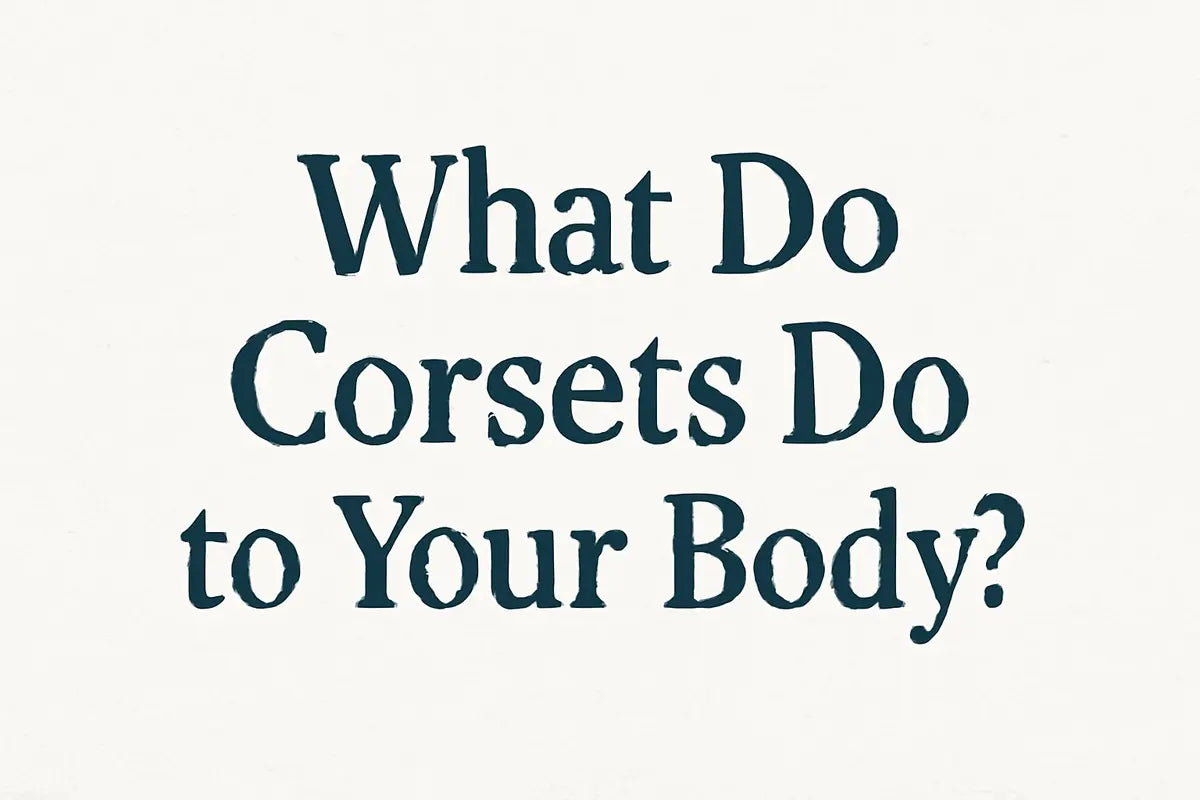What do corsets do to your body? Corsets temporarily reshape your waist, improve posture, and compress internal organs. When worn correctly, they create a smaller waist, often resulting in a more defined hourglass shape. However, corsets can also cause health risks, such as restricted breathing, muscle weakness, and organ compression.
While corsets are primarily used today for body shaping and waist training, their long-term effects can vary. This article will explore both the positive and negative impacts of corset wear on your body, including their role in fashion and health. We’ll also address common concerns like “Are waist trainers safe?” and “How do corsets change your body shape?” so you can make an informed decision before trying them yourself.
What Are Corsets?
Corsets are tightly-fitted garments designed to shape and support the body, particularly the waist and torso. Originally made from stiff fabrics like leather and silk, they were once used for creating a desirable figure, particularly during the 18th century. Over time, they have evolved into modern waist-shaping garments and posture correction tools.
Today, corsets are used in various forms—whether for aesthetic purposes in fashion or for waist training in fitness. One popular style is the underbust corset, which offers comfort and flexibility while still providing effective waist shaping. Modern corset designs, including underbust corsets, have become more comfortable and health-conscious, reducing the risks historically associated with tight-lacing.
How Do Corsets Affect Your Body Physically?

Wearing a corset has both immediate body-shaping effects and potential long-term health consequences. To ensure you're achieving the best fit and comfort while wearing a corset, it’s essential to lace it properly. For those new to corset wear, learning how to lace a corset can help avoid discomfort and ensure effective waist shaping.
Corset Body Shaping – What Happens to Your Waist?
When worn correctly, corsets compress the waist, providing a temporary reduction in waist size and creating an hourglass figure. While corset waist training can lead to visible results, it’s important to remember these effects are temporary and can fluctuate once the corset is removed.
Corset and Posture – Support or Constraint?
Corsets are well-known for their ability to improve posture by providing spinal support. For individuals with back problems or poor posture, wearing a corset can serve as a tool for posture correction. It helps prevent slouching by supporting the back and aligning the spine.
However, wearing a corset for long periods can also restrict natural movement, especially in the lower back, which might eventually weaken muscles over time if worn too often.
Corset Impact on Internal Organs
Corsets compress internal organs, such as the ribs, intestines, and stomach. This compression may lead to digestive discomfort, including bloating, constipation, or indigestion. In extreme cases, wearing a corset too tightly can cause organ displacement.
If you're using a corset regularly, it’s crucial to avoid excessive tightness to minimize these risks.
Corset and Breathing Difficulties
One of the most common concerns with tight corset wear is its impact on breathing. Tight lacing can restrict lung expansion, leading to breathing problems. For those who wear corsets daily, this can cause shortness of breath, dizziness, and even fainting in extreme cases, especially when engaging in physical activity.
Health Benefits of Wearing Corsets

While there are risks associated with corset use, there are also benefits, especially if worn correctly and in moderation.
Posture Improvement
Corsets are excellent for posture correction. When worn correctly, they support the spine, helping to alleviate back pain caused by poor posture. This makes corsets especially useful for those who spend long hours sitting at desks or working in office environments.
Waist Training and Body Shaping
The primary goal of corset waist training is to reduce the waist size temporarily and create a more defined hourglass shape. Although results may not be permanent, regular use can shape the body and encourage proper posture.
It's important to remember that waist training doesn’t provide instant results. So, if you're wondering how long does corset waist training take, the process depends on how consistently you wear the corset and how tightly it’s laced. Some individuals see visible results within a few weeks, while others may require several months of consistent use for noticeable waist reduction.
However, it's important to use corsets safely, as excessive waist training may lead to health issues such as muscle weakness or internal organ compression.
Support During Physical Activity
For individuals who struggle with back pain or need extra support during activities like weightlifting, corsets can serve as a supportive back brace. This helps stabilize the core muscles and alleviate discomfort.
Potential Risks of Wearing Corsets

Despite the benefits, wearing corsets comes with potential health risks. Let’s discuss these in more detail.
Corset Body Compression – Organ Compression Risks
Corset body compression can lead to serious health risks, such as internal organ displacement, digestive problems, and even damage to the ribs. Prolonged use of a tightly laced corset can impair circulation, restrict lung expansion, and affect digestive health. It's important to avoid wearing corsets too tightly or for extended periods.
Corset and Breathing Difficulties
As mentioned earlier, wearing a tight corset can restrict breathing. This can lead to shallow breathing, oxygen deprivation, and dizziness, especially during physical activities like exercise.
Muscle Atrophy
Over-reliance on a corset can result in muscle atrophy in the core muscles. Corsets essentially take over the task of supporting the torso, leaving the muscles underused and weak. Over time, this can lead to poor posture when the corset is not worn.
Are Corsets Safe for Everyday Wear?
Wearing a corset every day is not recommended due to the health risks associated with prolonged use. Wearing corsets too tightly or for extended periods can lead to organ compression, restricted breathing, and muscle weakness. It’s important to wear corsets in moderation and ensure they are properly fitted for comfort and safety. If you’re unsure about the safety of daily corset wear, you might want to explore more on whether it’s safe to wear corsets every day to understand the potential long-term effects.
It's essential to wear corsets in moderation and make sure they're properly fitted to ensure comfort and safety.
Corsets and Waist Trainers – What’s the Difference?
Both corsets and waist trainers are used to shape the body, but they serve different purposes. Corsets are generally more rigid and provide strong posture support and body shaping. On the other hand, waist trainers are more flexible and often used for temporary waist shaping during workouts or daily wear. If you’re curious about how these two compare in more detail, check out our article on the corset vs waist trainer.
If you're looking for full-body support and shaping, overbust corsets provide a complete fit that shapes both the waist and the torso, including support for your bust. These are ideal for those who want to combine waist training with an added layer of chest support.
Corset Waist Trainer
A waist trainer is typically made of flexible materials and provides temporary waist shaping. Unlike traditional corsets, they do not provide the same level of posture support or compression. Waist trainers are typically used in fitness for shaping the waist and enhancing workout performance, but they can still lead to breathing issues if worn too tightly.
Conclusion
What do corsets do to your body? Corsets can help shape your waist, improve your posture, and support your spine. However, they also come with risks like organ compression, breathing difficulties, and muscle atrophy if worn incorrectly.
If you're considering wearing a corset for waist training, it's important to use it safely and in moderation to avoid health issues. Always ensure that you listen to your body and choose a well-fitted corset designed for comfort and support.
FAQs (Frequently Asked Questions)
How long should you wear a corset each day?
You should wear a corset for 2-4 hours a day for waist training, gradually increasing the time. Avoid wearing it for long hours to prevent muscle weakness and organ compression. Always listen to your body and take breaks as needed.
Can corsets cause permanent changes to your body shape?
No, corsets provide temporary body shaping. While waist training can reduce waist size temporarily, the effects reverse once you stop wearing the corset. Permanent changes require diet and exercise alongside corset use.
Are there any specific body types that should avoid wearing corsets?
People with respiratory issues, cardiovascular conditions, or those pregnant should avoid wearing corsets. Always consult a doctor if you have underlying health conditions before wearing a corset.
How do modern corsets differ from historical ones?
Modern corsets use flexible materials and ergonomic designs for comfort and safety. Historical corsets were more rigid, often causing organ compression and restricting movement, leading to severe health risks.
Can wearing a corset help with posture during exercise?
Yes, corsets can provide spinal support during exercises like weightlifting. However, they should be used in moderation and not replace core strengthening exercises for long-term posture improvement.
Are corsets effective for reducing belly fat?
No, corsets don’t reduce belly fat. They can temporarily shape the waist, but fat loss requires diet and exercise. Corsets only provide a contoured appearance, not permanent fat reduction.
Can corsets be worn during sleep?
It’s not recommended to wear a corset while sleeping. Doing so can cause discomfort, restrict breathing, and weaken muscles. Corsets should be worn during the day, and breaks should be taken to allow the body to relax.



